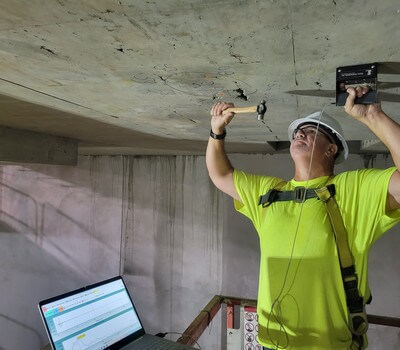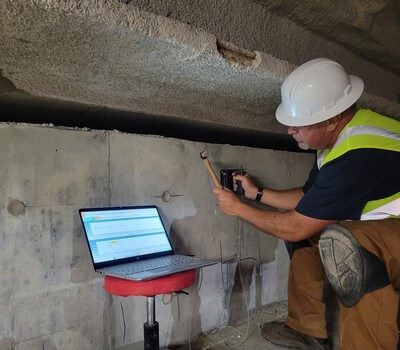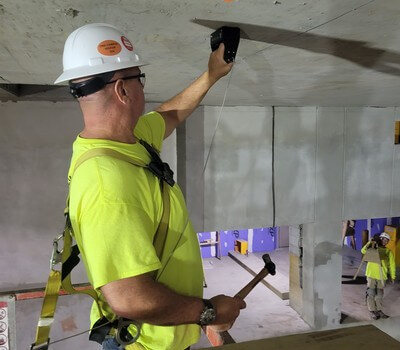Impact Echo (IE) Services

The IE method can be used for measuring concrete thicknesses, evaluating concrete quality, and detecting hidden flaws such as cracks, delaminating, honeycombs, etc. The IE test data is recorded on a field laptop during the field NDE and initially analyzed in the field. A subsequent report is produced in the office.
The IE tests involve impacting the concrete slab with an impactor (hammer) and
identifying the resonantly reflected compressional wave energy with a displacement transducer. All IE test data will be collected with an Proceq PI800 and/or Olson Instruments CGT-2. The test head is pressed against the concrete and held while tests were performed with an 8-ounce ball peen hammer. The resonant echoes of the displacement responses are generally not as apparent in the time domain, but are more easily identified in the frequency domain. Consequently, amplitude spectra of the displacement responses are calculated by performing a Fast Fourier Transform (FFT) analysis to determine the resonant echo peak(s). The relationship among the resonant echo depth frequency peak (f), the compression wave velocity (VP), and the echo depth (D) is expressed in the following equation:
D = Vp/(2*f) (1)

An unflawed slab/wall shape has a single-thickness resonance while unflawed beam and column shapes can have multiple resonances due to their cross-sectional shape. A nominal velocity of 13,000 fps (156,000 inches/second) is assumed for the concrete walls and slabs based on the SASW measured velocities and comparisons with the known nominal 12 inch wall thickness, and used to compute the measured thicknesses. If cracks or larger voids in the concrete are parallel or subparallel to the test surface, shallow echoes may also be recorded from depths that correspond to the flaws. Distributed honeycomb/void may not result in such shallow echoes, but rather the false increase in backside echo depth due to the lower stiffness and associated resonant echo frequency due to the honeycomb/void.

Bullet Points:
- Measuring concrete thickness, including “thicker” concrete with a 99% accuracy level
- Evaluating concrete quality
- Detecting hidden flaws in the concrete such as delamination, honey-combing, cracks and voids
- Pile integrity testing to depths as great as ~(30-50 ft) below grade
- Asset inspection of buildings/bridges/etc.
- Mapping of concrete plate thickness
- Newest technology and equipment used for all projects including *Proceq PI8000*, and Olson Instruments

